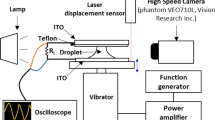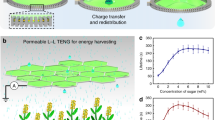Abstract
For more than a decade, energy harvesting devices have been rapidly developed based on the electrical energy conversion techniques from kinetic energy using piezoelectric, electrostatic, and electromagnetic principles. However, the amount of power is insufficient for practical products. Recently, a new concept of energy generation, the reverse electrowetting technology has been invented. This method demonstrates that an oscillating water bridge between two parallel conducting plates can generate an AC electric power. The electrical double-layer capacitors formed on the two interfacial areas of a water bridge and plates are continuously charged and discharged when the shape of the bridge between two plates while the bottom plate is oscillating. For this research, we treat surfaces of each plate hydrophilic and hydrophobic, give variety to vibration frequency, amplitude and droplet size. Though the images of liquid bridge taken by a high-speed camera, the size of contact area is measured and flow field is observed by PIV, then we find a correlation with output voltage signal. This observation could contribute to more accurate prediction of the behaviors of oscillating droplets and development of micro-fluidic power generation devices.
Graphical abstract














Similar content being viewed by others
References
De Gennes PG (1985) Wetting: statics and dynamics. Rev Mod Phys 57:827–863
De Gennes PG, Brochard-Wyart F, Quere D (2004) Capillarity and wetting phenomena. Springer, New York
Grahame DC (1947) The electrical double layer and the theory of electrocapillarity. Chem Rev 41:441–501
Heyden FHJ, Bonthuis DJ, Stein D, Meyer C, Dekker C (2007) Power generation by pressure-driven transport of ions in nanofluidic channels. Nano Lett 7:1022–1025
Israelachvili JN (1992) Intermolecular and surface forces, 2nd edn. Academic Press, New York
Klarman D, Andelman D, Urbakh M (2011) A model of electrowetting, reversed electrowetting, and contact angle saturation. Langmuir 27:6031–6041
Krupenkin T, Taylor JA (2011) Reverse electrowetting as a new approach to high-power energy harvesting. Nat Commun 2:448–454
Moon JK, Jeong J, Lee D, Pak HK (2013) Electrical power generation by mechanically modulating electrical double layers. Nat Commun 4:1487
Mugele F, Bare J-C (2005) Electrowetting: from basics to applications. J Phys 17:705–774
Parsons R (1990) The electrical double layer: recent experimental and theoretical developments. Chem Rev 90:813–826
Sharma P, Bhatti TS (2010) A review on electrochemical double-layer capacitors. Energy Convers Manage 51:2901–2912
Simon P, Gogotsi Y (2008) Materials for electrochemical capacitors. Nat Mater 7:845–854
von Helmholtz (1879) H. L. F. Ann Phys Chem 7:337
Acknowledgments
This research was supported by Global Ph.D Fellowship Program through the National Research Foundation of Korea (NRF) funded by the Ministry of Education (NRF-2014H1A2A1022186) and by the Korea government (MSIP) (No. 2012R1A6A3A01041077). This work was also supported by the Energy Efficiency & Resources Core Technology Program of the Korea Institute of Energy Technology Evaluation and Planning (KETEP) granted financial resource from the Ministry of Trade, Industry & Energy, Republic of Korea (No. 20132020000390).
Author information
Authors and Affiliations
Corresponding author
Rights and permissions
About this article
Cite this article
Kim, D.Y., Kim, H.D. & Kim, K.C. Visualization study on the behaviors of oscillating liquid bridge between two parallel plates with surface treatments. J Vis 18, 531–542 (2015). https://doi.org/10.1007/s12650-015-0285-y
Received:
Revised:
Accepted:
Published:
Issue Date:
DOI: https://doi.org/10.1007/s12650-015-0285-y




